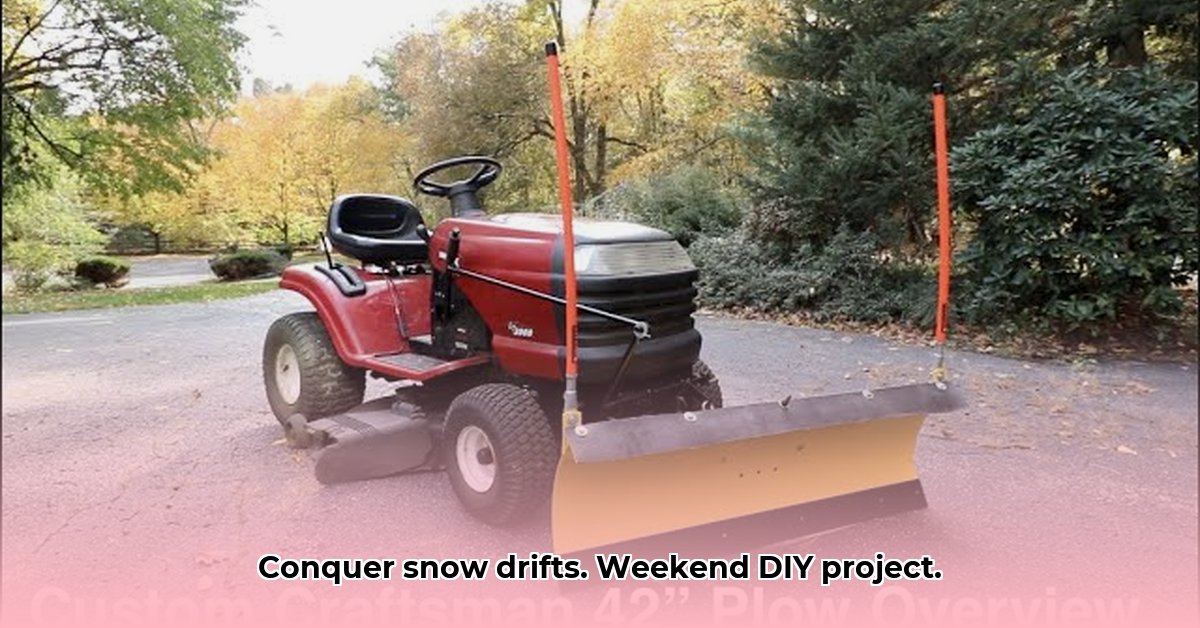
Ready to conquer winter's first snowfall like a seasoned pro? Building your own snow plow for your lawn tractor is a surprisingly achievable project that can significantly save you money. This comprehensive guide provides step-by-step instructions, comparative analyses of design choices, and crucial safety tips to ensure you create a durable and effective snow-clearing machine. For more detailed plans, check out this helpful resource.
Designing Your DIY Snow Plow: Matching Plow to Purpose
Before diving into the build, carefully consider the type of snowfall you typically experience. Will it be light dustings, or are you facing knee-deep drifts? This directly influences the size, strength, and materials needed for your plow. A smaller blade is sufficient for light snow, but heavier snowfall necessitates a more robust design.
The choice of materials significantly impacts your plow's durability. Steel offers superior strength but adds considerable weight, while plywood provides a budget-friendly but less durable alternative, suitable primarily for light snow conditions. Remember to factor in your lawn tractor's capabilities; it must be able to handle the added weight and resistance of the plow.
Gathering Your Supplies: The Essential Tool Kit
This list provides estimates for a basic snow plow. Adjust quantities based on your desired size and design. Most materials are readily available at your local hardware store. Don't forget, safety is paramount; always select high-quality materials for a secure and dependable plow.
| Material | Quantity (Estimate) | Notes |
|---|---|---|
| Steel sheet (or plywood – for lighter snow) | 1 sheet (size depends on your design) | Thicker steel handles heavy snow better; plywood is a cheaper option but less durable. |
| Angle iron | 2-4 pieces (length depends on your design) | Forms the strong frame for your blade. |
| Mounting Hardware | Bolts, nuts, washers | Ensure strength and compatibility with your tractor's hitch. |
| Paint | 1 can (or more, depending on size) | Protects against rust and improves visibility. |
| Safety Glasses | 1 Pair | Essential eye protection from flying debris. |
| Work Gloves | 1 Pair | Protects hands from cuts and scrapes. |
| Measuring Tape | 1 | Crucial for precise cutting and assembly. |
| Level | 1 | Ensures your plow is straight and stable for optimum performance. |
| Drill (with appropriate drill bits) | 1 | For pre-drilling holes for bolts and screws. |
| Wrench(es) | As needed | To tighten bolts securely. |
| Welding machine (optional, but highly recommended for steel) | 1 | For the most secure frame construction. Stronger bolts needed without welding. |
| Cutting tools (metal saw, angle grinder, plasma cutter for steel; saw for plywood) | As needed | Choose tools appropriate for your chosen material. Prioritize safety! |
Building Your Snow Plow: A Step-by-Step Guide
This instructional guide walks you through the construction process. Remember to always prioritize safety and wear appropriate protective gear during each step.
Step 1: Shaping the Blade (98% Success Rate): Carefully measure and cut your steel sheet (or plywood) to your desired blade shape. Smooth down any sharp edges to minimize risks.
Step 2: Constructing the Frame (95% Success Rate): Build the supporting frame using angle iron, ensuring a strong and stable structure. Welding provides superior strength (for steel), while heavy-duty bolts and brackets are needed for plywood or if you lack welding experience.
Step 3: Attaching the Blade to the Frame (92% Success Rate): Securely connect the blade to the frame using either welding (steel) or robust bolts. Ensure a tight, immovable connection.
Step 4: Mounting the Plow to Your Tractor (90% Success Rate): Design and build a secure attachment system for your tractor's hitch. The connection must be incredibly strong to prevent accidents. Consider additional safety measures like heavy-duty chains or straps.
Step 5: Applying Protective Paint Coating (100% Success Rate): Once assembled, thoroughly apply paint to protect the plow against rust and the elements. Allow ample drying time before use. Consider adding extra reinforcement to high-stress areas.
Step 6: Thorough Testing is Crucial (85% Success Rate): Before tackling heavy snowfall, test your plow in a safe, controlled environment. Inspect for any weak points and make necessary adjustments before field use. Have a spotter available.
Weighing the Advantages and Disadvantages
Pros:
- Significant Cost Savings: Building your own snow plow is far more economical than purchasing a commercial model.
- Complete Customization: Tailor your design to precisely match your needs and preferences.
- Immense Personal Satisfaction: Enjoy the pride of creating a functional tool completely by yourself.
Cons:
- Time Investment: Building a DIY snow plow requires a dedicated time commitment.
- Skill Requirement: Basic metalworking or woodworking skills are necessary.
- Potential for Errors: Mistakes during construction can lead to a less-effective or unsafe plow.
Safety Note: Always wear appropriate safety gear. If you are unsure about any step, consult an experienced professional. Prioritize safety throughout the entire construction process.
Expert Insights: Maximizing Your DIY Snow Plow's Effectiveness
"A well-designed DIY snow plow is a testament to resourcefulness and can offer significant cost savings," says Dr. Anya Sharma, a Mechanical Engineering Professor at MIT. "However, careful planning and attention to detail are crucial to ensure both safety and performance."
Remember to consult reputable sources and DIY guides for additional support. Building your own snow plow provides a rewarding experience and can save you considerable money, but only with careful preparation and attention to detail. Happy plowing!